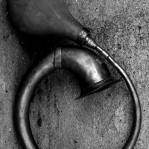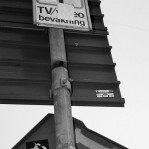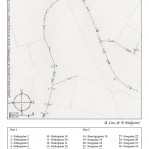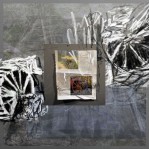Da Capo al Fine
By Emil Ibjer & Lars Eklöw & Ylva Cerne En samling gamla trötta instrument har fått nytt liv igen genom möllans försorg och akustiken i silosen.
En samling gamla trötta instrument har fått nytt liv igen genom möllans försorg och akustiken i silosen.
Installation:
Ett antal olika instrument placeras hängande i en liten silos, där spegeleffekter mångfaldigar dem. Besökarna får möjlighet att via olika konstruktioner spela på några av instrumenten och uppleva hur volymen och materialet i silosen fungerar som en stor resonanslåda.
Bios:
Emil Ibjer is an operasinger and the owner of Spiken I Kistan in Lövestad. He has made some public installations with antiques.
Lars Eklöw is an artist and musician drumplayer, and the owner of Kulturmöllan.
Ylva Cerne is an cartoonist and an owner of a red Ukulele.
Änglars frusna tårar/Angels frozen tears
By Tuss Marie Lysén[:se,gb] [:se,gb]An installation/audio-visual ; a poem
[:se,gb]An installation/audio-visual ; a poem
Part of the project Earth song/en sång till jorden.
This project started 2004 and includes: installations, sculptures, drawings, paintings, photo, video, texts,
graphics, sound etc.
Installation:
Hängande skiva med små avrinningskanaler (det formella kommer säkert att ändras lite)
stor rå kub av is som sakta smälter.
Under detta: ett kar/oljefat el. liknande, kanske stationär behållare som finns på plats?
En riktad mikrofon som fångar ljudet av fallande/rinnande vatten/droppar,
så småningom fallande i vatten, omgivande ljud , steg och röster blandar sig med
droppljuden som på grund av mikrofonens riktning hörs tydligt,metalliskt högt,eventuellt eko/rymdfunktion.
Ljuden hörs samtidigt som allt spelas in/filmas ( svartvit film )
filmen med ljud projeceras(loopas) sedan på plats, när isen smält,
och vattnet är stilla, under återstoden av utställningen.
Installation:
A hanging flat object with small pipes for melted water (the formal structure might change a little)
On the surface a large, raw cube of ice (frozen water) slowly melting.
Underneath the hanging object: a container or something similar ; maybe something stationary that is in the mill?
A pointed microphone that records the sound of falling waterdrops as they hit the surface, and as time elapses, the water in the container rises and consequently the sound changes and also the surrounding sounds, steps and voices mix with the drop sounds. The sound of the drops can be heard very loudly, metalically and painfully clear, maybe with an echo or “space” effect.
The installation will be filmed in black and white and the sound amplified in the room simultaneously. When the ice is melted and the water is still, the film will be projected ,looping on the spot of the installation for the rest of the exhibition time.
Bio:
Tuss Marie Lysén lives and workes in Malmö, Sweden. She works with many different medias, where the media and materials follows the idéas. Her work has often political undertones. Text and sound are important components in her work. Formally she seeks poetic simplicity.
rostrum.nu
A Line & A Midpoint
By Amanda Buonocore Instrument: The way the “instrument” works is the viewer turns the handle on the rotating form. As the handle is turned thread is fed from the spools through section 2. As the thread moves through this section the different colors vibrate and shake creating a simple kinetic pattern. These separated channels converge at section 3 before fanning out and being collected directly on the rotating form. As the form gathers these different colors it beings to randomly layer the colors creating a unique pattern. The thread on each spool is a specific length that is equivalent to the distance in yards from the mill to a landmarked location in Lövestad. Due the various lengths of thread on the spools, the thread channels will empty at different moments. Once all the spools are empty the process has been completed. This process should extend the length of the exhibit allowing different viewers to participate with the instrument. Once the process is completed the pattern of color collected on the rotating form becomes a record or remnant of the process.
Instrument: The way the “instrument” works is the viewer turns the handle on the rotating form. As the handle is turned thread is fed from the spools through section 2. As the thread moves through this section the different colors vibrate and shake creating a simple kinetic pattern. These separated channels converge at section 3 before fanning out and being collected directly on the rotating form. As the form gathers these different colors it beings to randomly layer the colors creating a unique pattern. The thread on each spool is a specific length that is equivalent to the distance in yards from the mill to a landmarked location in Lövestad. Due the various lengths of thread on the spools, the thread channels will empty at different moments. Once all the spools are empty the process has been completed. This process should extend the length of the exhibit allowing different viewers to participate with the instrument. Once the process is completed the pattern of color collected on the rotating form becomes a record or remnant of the process.
Installation:
- A long wooden compartmented box attached to wall houses a variety of thread spools with differing lengths of thread.
- Cotter pins are inserted into the wall so that the looped head sticks out. These cotter pins create the channel to which the thread will be fed. The distance of each thread channel is 1 yard. The distance between thread channels is 1 inch.
- In section 3 another cotter pin is inserted into the wall. The loop of this pin opens from the top. All the threads from the channels in section two will be fed down through this pin.
- The threads fed from section 3 are tied to rods on the rotating form. By turning the handle on the rotation form: the spools in section one spin, the thread travels through section two, continues down through section 3, and branches out creating a random colorful pattern on the rotating form.
Bio:
Amanda Buonocore is a visual artist living and working in the New York Metro Area. She has exhibited at the Museum of Contemporary Art Detroit, SOHO20, and The Governor’s Island Art Fair, among other locations. She received her Masters of Fine Arts from Cranbrook Academy of Art, located in Bloomfield Hills, Michigan, and her Bachelors of Fine Arts from Long Island University: C.W. Post. Through her work, she explores the potential of raw materials in a process of deconstruction and reconstruction, focusing on the differing results of repetitious actions.
Chalk and Charcoal: Dust-Producing Drawing Instruments for Replacing a Disappeared Mill
By Erik Sanner Viewer-participants encounter a video projection on a wall. In the video is a stream which used to power a mill near the artist’s hometown long before he was born. Viewer-participants are encouraged to draw a mill on the wall in the video projection using chalk or charcoal.
Viewer-participants encounter a video projection on a wall. In the video is a stream which used to power a mill near the artist’s hometown long before he was born. Viewer-participants are encouraged to draw a mill on the wall in the video projection using chalk or charcoal.
Installation:
A small low-power video projector containing an internal memory card is mounted on the ceiling and plays one video in a continuous loop. Two small containers containing chalk and charcoal are hung on the wall. Viewer-participants draw on the wall.
Bio:
Erik Sanner is a visual artist living and working in Harlem, NYC. He has recently exhibited at the Courtauld Institute of Art (London), LICHT FELD Gallery (Basel), The Danforth Museum (Massachusetts), Carmichael Gallery (LA) and Tria Gallery (NYC). Sanner’s overarching goals include expanding our experience of painting by utilizing technology and promoting awareness of traffic cone aesthetics.
eriksanner.com

